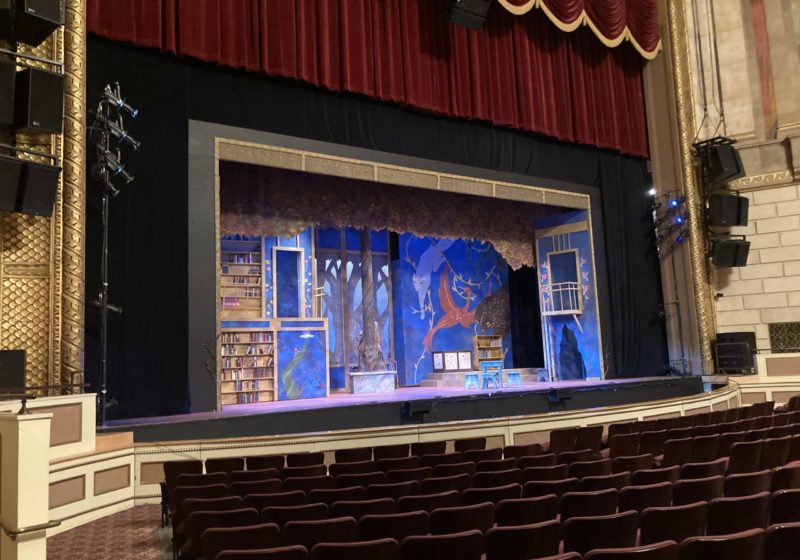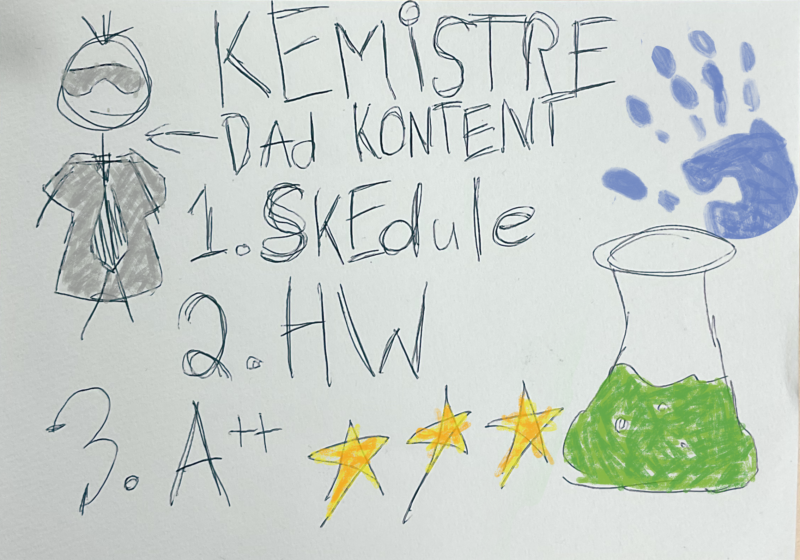The Eastman School of Music closed their production of “Into the Woods” on Sunday, April 11, after four shows with two full rotating casts. The CT had the pleasure of talking with senior Raffi Wright and juniors Meg Brilleslyper, Bel Lecomte, and Madelin Morales about their time in the show as well as the process of putting together an Eastman production with hybrid learning.
What was the process like for putting together “Into the Woods”?
Brilleslyper: The process for putting this show together was really exciting and packed. Since all of January was remote, we lost a lot of time for music rehearsals and everything got a bit crazier — we were able to have Zoom musical coachings, but it definitely was not the same as working in person. Once we got back to Rochester, it was a very busy few weeks with some long rehearsals, but we were able to put the show together!
Lecomte: “Into the Woods” was really fun to get to put together! I got to work with some teachers at Eastman that I hadn’t gotten the chance to work with prior to this project, and I got closer to my friends as a result. The rehearsal process started in January on Zoom with our director, Timothy Long, and our helpers, graduate students Maeve Berry, Ava Lindvog, and Georgia Mills.
Wright: The process of putting together “Into the Woods” was one of flexibility and adaptation. The spring mainstage opera is usually cast between November and December, which means rehearsals normally start in full swing by January. Brilliantly, Professor Lindsay Warren Baker, Professor Timothy Long, and Stage Manager Josh Lau cultivated an online rehearsal schedule that allowed us to still familiarize ourselves with the score and libretto. Stephen Sondheim’s work is a challenge for any musician. Even if one can play or sing all the right notes, there is still another layer of nuance that Sondheim composed into his shows. Because of this, the process of putting it together was tedious and pedantic, but in the end, extremely rewarding. I am so proud of my colleagues and the directorial team for bringing a show together in the midst of many restrictions. After almost three years of this, we were used to it by now. Artists adapt!
What was a normal day of rehearsal/tech like?
Brilleslyper: A normal tech rehearsal started at about 3:30 p.m. and went until about 10:30 p.m. We used the first few hours of rehearsal to run the ensemble scenes and any other spots that needed some fixing. Then we got all set up in Kodak Hall and into costume and then ran the show. There was a lot of starting and stopping, but that was needed to make this production as clean as possible.
Lecomte: We did all of our music learning remotely, and we didn’t start working on scenes and character work until we came here in person in February. However, we did get to work with our director to flesh out our characters before we started working on campus. That way, we could start putting the scenes and transitions together right away, as well as working on building our relationships to our characters and to ourselves. It was really powerful to see it finally come together after a month of being apart.
Wright: We had graduate conductors and piano collaborators and graduate directors assisting Professor Long and Professor Baker, so we were able to coach several different scenes simultaneously in different rehearsal spaces. Because the show was double-cast (this gives more opportunities for people to have roles during their time at Eastman), when we had full-company calls, we would have over 50 people in a room at once. Imagine that! 50 opera singers from the Eastman School singing Sondheim together. I’ll remember that forever. To be in the midst of excellence is such a joyous and thrilling experience. I am grateful to all for their care and focus in rehearsals. We, of course, made time for some “behind the scenes” jokes and laughter. “THIS IS A CHANGE!” and “She’s in critical condition” — there’s a couple of them.
How was balancing the show with classes as music students?
Brilleslyper: Balancing the rehearsal schedule with class is never an easy task. It requires a lot of time management skills and communication with professors. A lot of us are able to get some homework/studying done when we are on breaks or when we are not needed for a particular scene, but oftentimes it takes some late nights to make sure we don’t fall too far behind in classes.
Wright: Balancing any show at Eastman on top of the Eastman workload is always a tremendous challenge, sometimes bordering on the impossible. For reference, most vocalists must be enrolled in at least 20 credits per semester in order to graduate from the School in four years. As a double major with a few certificates, I have been enrolled in at least 27.5 credits for six semesters. You can imagine the kind of stress that weighs on one who does this — I am NOT the only one. With all that said, everyone loves what they do at the School and we love each other, so even in those exhausting moments, we are still experiencing the joy of creating art with one another.
How does the audition process function for Eastman shows?
Brilleslyper: For Eastman productions, the directors usually ask students to prepare a piece in the style of the show. For “Into the Woods,” they were, of course, looking to hear some musical theater.
Morales: We are given five-minute time slots to present our pieces to the panel — for “Into the Woods,” we had an initial audition in Kodak Hall — and then callbacks were held a couple weeks later. We were told to prepare specific scenes from the show for the callback.
Wright: The environment at Eastman is incredibly supportive but extremely competitive. You have some of the country’s best young singers gathered in one place — anyone could play any role.
For those of you who covered multiple roles, what was the process of learning your roles like? Also, what was your favorite role to play and why?
Brilleslyper: Covering the role of the Witch while also playing Granny was a really fun challenge! I got to learn so much from the two seniors playing the Witch and I got to have a lot of fun with the role of my own! It sometimes got confusing trying to keep the staging for each character clear in my head, but I had a great time with this challenge. It was a bit nerve-wracking to know I could be called at any moment to cover the Witch, but that is what the real world is like. I loved playing the Granny, but in my opinion the Witch is the best character in this show!
Morales: The rehearsal process as a cover was very different from what I usually experience! I started out as the cover for Rapunzel, so the first two months of rehearsals, I just focused on her track. A lot of the learning I did was just by actively watching rehearsals and taking notes; that way I would be ready to jump in if needed. About two weeks before we opened the show, our director asked me to also cover the roles of Sleeping Beauty and Snow White, so I had to learn their tracks a lot faster. At this point, the whole show was already blocked, so I had separate meetings to walk through the Sleeping Beauty and Snow White tracks. When I agreed to cover multiple roles, I never thought I would be needed for the actual shows, but I ended up being needed for all four shows! After putting all this time and work into the rehearsal process, it was great to be able to put that work to use and perform!
How did your character(s) and the show in general challenge you as an actor and singer?
Wright: I have loved the Baker for a long time. He is an empathetic man who loves his wife, wants the best for those around him, and is emotionally sensitive to those around him. With any role or story I tell, I try to experience not so much the challenge, but the privilege of becoming the person I am portraying. It takes great focus, but it is some of the most beautiful, human work I will ever do in my life. Studying people is such a gift. This is why I love art! The show challenged me because of how quickly-paced it is. Like we see in life, so much chaos abounds within the production, and each and every line must be delivered with care and precise pacing, or it will fail. Musically, it was a fun challenge to stay true to the written score instead of doing what we had all heard through the years. Sondheim wrote deliberately, and we all aimed to honor his work as a composer. Some of his lyrics are so powerful but move so quickly, so the deliverer has to take great care in communicating so that nothing is lost.
Morales: As the show’s “swing,” covering multiple roles was a challenging task, but so rewarding. Being asked to jump in at the last minute takes courage, and I am proud of myself for stepping up to the task and pushing my anxieties aside to make sure the show went on!
What is your favorite moment from the show (either in rehearsal or in performance)?
Morales: I love when Snow White and Sleeping Beauty sneak up and kill the cow, Milky White. We always had a lot of fun with it, and it’s always nice to get some laughs out of the audience!
Brilleslyper: My favorite moment from the show is definitely the big ensemble finale at the very end. I loved sharing the stage with such talented, wonderful people and the choreography was so much fun. I also loved the tech rehearsals (despite how long they were) because I really got to know more people in the cast and I think we all made some amazing bonds.
Wright: I loved the laughter we shared in the rehearsal room, as well as the more moving moments. The rehearsal process always feels so intimate to me. Someone would say something funny, make a hilarious mistake, or make a comedic choice, and we would all erupt into laughter. It is such a joy to work with people I love. My heart is so full because of the collaboration we shared in this production — between directors, cast, crew, and the orchestra. Sitzprobe — the first time we hear the orchestra — is always a thrilling rehearsal. It is inspiring to collaborate with the instrumentalists at Eastman; vocalists do not get to do this a lot. “Children Won’t Listen” and “No More” are two moments from the show that encompass decades of life experience in a moment. I will cherish these songs as long as I live.




